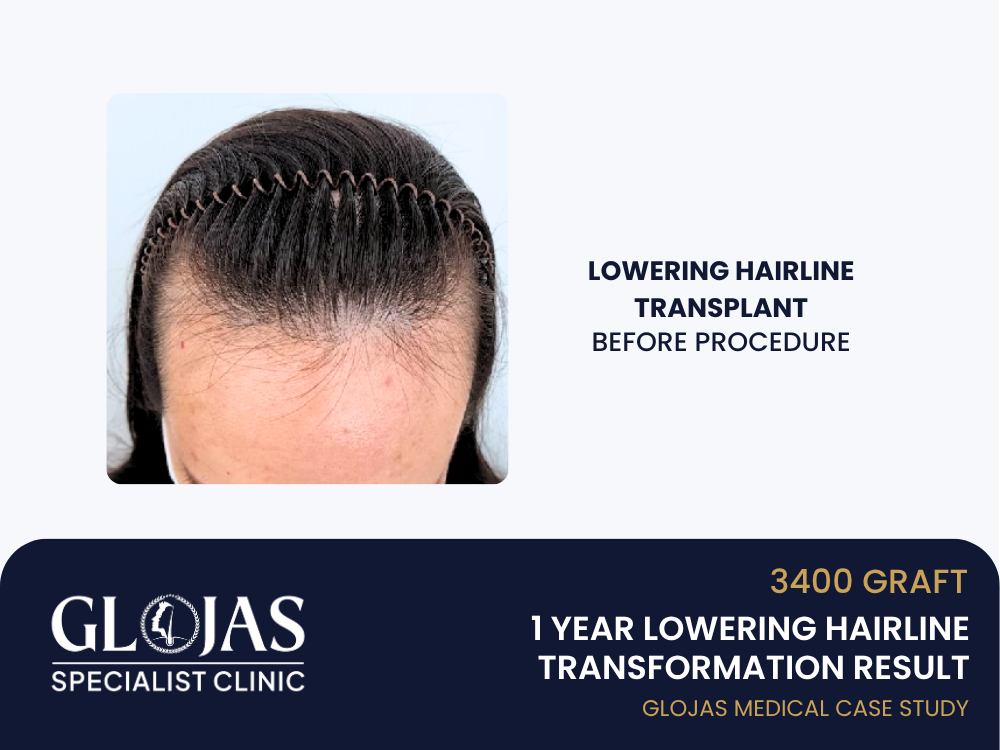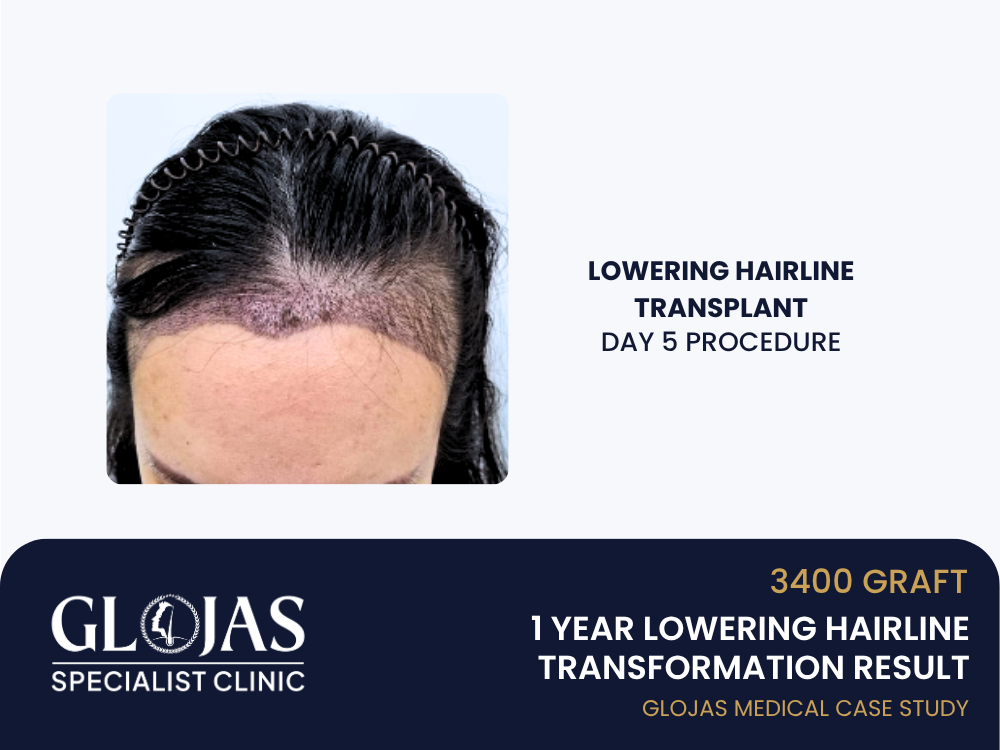For many women, a balanced hairline is not just about aesthetics — it impacts confidence, hairstyle options, and facial harmony. A wide forehead or receding hairline can make one appear older or overly self-conscious in social and professional settings. Traditional surgical hairline lowering carries risks like scarring and stiffness. That’s where SMART™ FUE Hairline Transplant offers a minimally invasive, natural-looking solution.
In this case study, we share the journey of a 29-year-old woman who underwent a SMART™ FUE hairline transplant using 3,400 grafts to create a lower, more feminine hairline. One year post-procedure, her transformation is both natural and confidence-boosting.
Patient Profile
Age: 29
Concern: Naturally wide forehead, slight hairline recession since the early 20s
Goal: Lower and feminize the hairline while maintaining a soft, natural look
Donor Area: Occipital scalp (back of the head)
Hair Type: Fine, slightly wavy, dark brown
Motivation: Cosmetic enhancement for personal confidence, a better frame for the face
Why SMART™ FUE for Hairline Transplant?
Unlike surgical scalp advancement, SMART™ FUE provides a non-invasive, precise method of redesigning the frontal hairline.
Benefits include:
No major linear scarring
Individual hair direction control
Natural density and shape, especially for women
High graft survival rate
Customizable to suit face shape and forehead dimensions
In this patient’s case, her forehead height was approximately 7 cm above the ideal range of 5–6 cm for female proportions. She desired to reduce this by about 1.5–2 cm and round out the corners for a more oval, youthful face.
Consultation & Planning
Key Evaluations:
Healthy donor hair supply
No underlying scalp conditions or autoimmune issues
Clear hairline design preferences (curved vs straight)
Realistic expectations on hair density and growth rate
Design Plan:
New hairline placed 1.8 cm lower centrally
Rounded temporal peaks for a softer contour
Natural density with irregularities to mimic a real hairline
Total Grafts Required: 3,400 (mainly single follicles in front rows)
Procedure Overview

Technique Used: SMART™ FUE (0.7 mm punch size)
Duration: Full-day session (approximately 9 hours)
Grafts Extracted: 3,400
Anesthesia: Local anesthesia
Implantation Tools: Choi implanter pens for directional accuracy
Procedure Steps:
Hair trimmed in the donor zone
Grafts harvested with minimal trauma
Sorted into singles, doubles, and triples
Hairline outlined with fine markings
Grafts are implanted front-to-back with natural angulation
Recovery Timeline

| Timeline | Progress |
|---|---|
| Day 1–3 | Mild swelling, redness along the frontal scalp |
| Week 1 | Small crusts form and fall off by the end of the week |
| Week 3–4 | Temporary shedding phase (“shock loss”) |
| Month 3 | First signs of new growth, soft baby hairs, emerge |
| Month 6 | 60–70% of grafts showing growth; visible improvement |
| Month 12 | Full density and contour visible; patient styling freely |
1-Year Results

At 12 months, the patient’s hairline was naturally blended and perfectly shaped to suit her face.
| Before | After (12 Months) |
|---|---|
| Forehead height: 7 cm | Forehead height reduced to ~5.2 cm |
| The hairline is thin at the corners | Soft, rounded edges framing the face |
| Hair pulled back, exposing a wide area | Now, they can wear ponytails and partings confidently |
Patient Testimonial
“This changed how I feel about myself. I no longer hide behind bangs or avoid photos. The results are so natural, even my hairstylist didn’t realize I had a transplant!”
Aftercare Summary
Sleep upright for the first 3 nights
Avoid touching, scratching, or washing the hairline for 5 days
Use saline spray and mild shampoo as directed
Avoid strenuous exercise and sun exposure for 2 weeks
PRP booster is optional at 3–6 months to support growth
5 Frequently Asked Questions (FAQ)
1. Is SMART™ FUE hairline transplant suitable for women?
Yes, it’s particularly effective for women with high foreheads, naturally receding hairlines, or those wanting to improve facial balance without invasive surgery.
2. How long do the results last?
The transplanted hair is permanent and will continue to grow like natural hair. Occasional maintenance (e.g., trimming or shaping) is all that’s required.
3. Will the new hairline look obvious?
No. With SMART FUE, the design is tailored to feature irregular and natural density patterns, ensuring a completely natural appearance, even under close inspection.
4. Is there scarring?
Tiny dot scars may appear in the donor zone but are typically hidden under your existing hair and barely visible, especially with fine punches used in SMART™ FUE.
5. Can I style my hair as usual after the transplant?
Absolutely. After 3–4 months, you can style, dye, curl, or part your hair just like normal. Many patients enjoy wearing their hair pulled back confidently.
Conclusion
This case is a perfect example of how SMART™ FUE Hairline Lowering Transplant can restore balance, boost confidence, and offer natural, long-term solutions to women dealing with a wide forehead or receding hairline.
With 3,400 grafts carefully implanted, the patient now enjoys styling freedom, enhanced beauty, and a rejuvenated sense of self, proving that modern hairline restoration is not just for men but a powerful option for women too.
